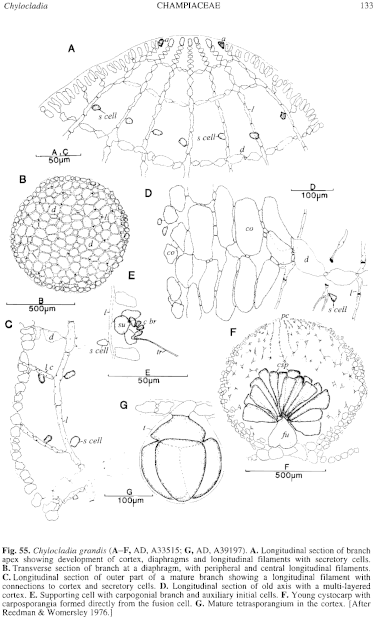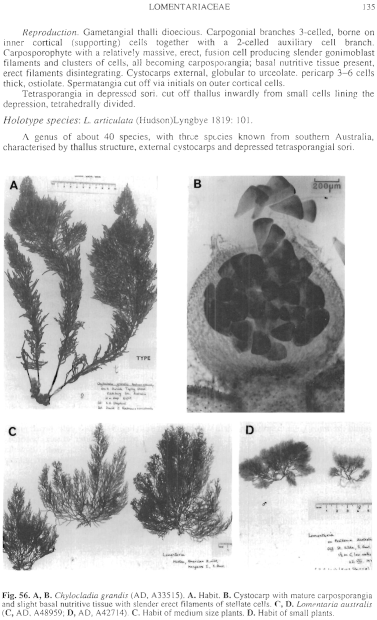|
|
|
|
|
|||||||||||
|
Electronic Flora of South Australia Species Fact Sheet
Phylum Rhodophyta – Class Florideophyceae – Order Rhodymeniales – Family Champiaceae
Thallus (Fig. 56A) red-brown to red-purple, 20–50 cm high, with one to several percurrent terete axes 2–7 mm in diameter, often denuded below, from a hard, branched, perennial base to 5 cm high and 3–7 mm thick, bearing opposite or usually whorled laterals to 10 cm long, similarly branched to a second or third order; laterals 1.5–2.5 mm in diameter, tapering to 0.7–1 mm in diameter in branchlets; branch bases slightly constricted, apices rounded; segments conspicuous throughout, L/D 0.5–1.5, slightly constricted at diaphragms. Holdfast discoid, 0.5–1.5 cm across; epilithic. Structure multiaxial with a group of 12–16 central and 15–20 peripheral apical cells (Fig. 55A), developing a cortex one cell thick in branchlets, cells ovoid and 25–35 (–40) in diameter, becoming up to 8 cells thick (Fig. 55D) in older axes; longitudinal filaments scattered throughout diaphragms (Fig. 55B), usually with two complete cells and two part cells between diaphragms, with each peripheral filament cell connected to the cortical cells by a lateral filament (Fig. 55C); most such cells bearing a secretory cell; hairs prominent. Diaphragms monostromatic. Rhodoplasts discoid to ribbon like, in chains in older cells.
Reproduction: Gametangial thalli probably dioecious. Carpogonial branches (Fig. 55E) 4-celled, with two 2-celled auxiliary cell branches, borne on primary cortical (supporting) cells in pit-connection with a peripheral longitudinal filament. Carposporophyte (Fig. 55F) with a basal fusion cell producing directly clavate to obconical carposporangia 130–200 µm in diameter; basal nutritive tissue moderate, with numerous slender erect filaments, outer cells stellate. Cystocarps (Fig. 56B) scattered, subspherical to slightly ovoid, 0.7–1 (–1.3) mm in diameter, broad based; pericarp 40–90 µm and 3–6 cells thick, inner cells stellate; non-ostiolate. Spermatangia not observed.
Tetrasporangia (Fig. 55G) scattered, transformed from primary cortical cells and protruding inwardly, 150–200 (–250) µm in diameter, tetrahedrally divided.
Type from Tapley Shoal, Edithburg, S. Aust., 15 m deep (Shepherd, 2.ii.1969); holotype in AD, A33515, with isotypes.
Selected specimens: Known from the type and Investigator Strait, S. Aust., 34 m, 23 m and 11 m deep (Watson, 20.i.1971; AD, A39197, 28.i.1971; AD, A41010, and 20.i.1971; AD, A40995 resp.). Ironstone Point (E of Penneshaw), Kangaroo I., S. Aust., 15 m deep (Lavers, 27.xi.1995; AD, A64550).
Distribution: Tapley Shoal and Investigator Strait, S. Aust.
Taxonomic notes: This distinctive species appears to be rare and from deep water.
References:
REEDMAN, D.J. & WOMERSLEY, H.B.S. (1976). Southern Australian species of Champia and Chylocladia (Rhodyméniales: Rhodophyta). Trans. R. Soc. S. Aust. 100, 75–104.
The Marine Benthic Flora of Southern Australia Part IIIB complete list of references.
Publication:
Womersley, H.B.S. (28 June, 1996)
The Marine Benthic Flora of Southern Australia
Rhodophyta. Part IIIB. Gracilarialse, Rhodymeniales, Corallinales and Bonnemaisoniales
Reproduced with permission from The Marine Benthic Flora of Southern Australia Part IIIB 1996, by H.B.S. Womersley. Australian Biological Resources Study, Canberra. Copyright Commonwealth of Australia.
Illustrations in Womersley Part IIIA, 1996: FIGS 55, 56A, B.

Figure 55 enlarge
Fig. 55. Chylocladia grandis (A–F, AD, A33515; G, AD, A39197). A. Longitudinal section of branch apex showing development of cortex, diaphragms and longitudinal filaments with secretory cells. B. Transverse section of branch at a diaphragm, with peripheral and central longitudinal filaments. C. Longitudinal section of outer part of a mature branch showing a longitudinal filament with connections to cortex and secretory cells. D. Longitudinal section of old axis with a multi-layered cortex. E. Supporting cell with carpogonial branch and auxiliary initial cells. F. Young cystocarp with carposporangia formed directly from the fusion cell. G. Mature tetrasporangium in the cortex. [After Reedman & Womersley 1976.]

Figure 56 enlarge
Fig. 56. A, B. Chylocladia grandis (AD, A33515). A. Habit. B. Cystocarp with mature carposporangia and slight basal nutritive tissue with slender erect filaments of stellate cells. C, D. Lomentaria australis (C, AD, A48959; D, AD, A42714). C. Habit of medium size plants. D. Habit of small plants.

|
Email Contact: State Herbarium of South Australia |

|